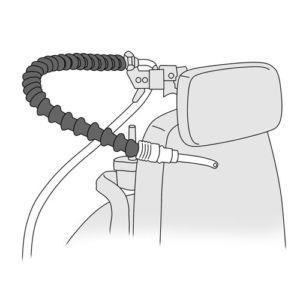Indications:
- Non-invasive ventilation with a mouthpiece helps the child to breathe better by mechanically pushing air and oxygen (O2) into the lungs (inspiration) and the child releases carbon dioxide (CO2) naturally by exhaling without assistance. Ventilatory assistance supports the child’s life and improves the child’s ability to do activities and to develop.
- This type of ventilation should only be used by a child who is aware of his breathing needs, is able to take the mouthpiece into his mouth and who can initiate breathing.
- Below is a suggested method that can serve as a guide; discuss the specific type of medical supplies and equipment used for your child with the healthcare team.
Considerations:
- Non-invasive ventilation with mouthpiece is an “as needed” type of ventilation where the child initiates use of the device to breathe in (inspiration) when desired. An expiration device is not required as the child breathes out independently.
- Non-invasive ventilation with a mouthpiece is only used when the child is awake, during the day, in complement with non-invasive ventilation with a mask that is used during sleep, at night.
- Non-invasive ventilation with mouthpiece also facilitates the technique of pulmonary hyperinflation which is used to enhance cough and clearance of secretions from the airways and lungs. The technique of pulmonary hyperinflation may also be combined with expiratory cough assist techniques.
- If your child requires medications during the time that non-invasive ventilation with a mouthpiece is being used, refer to your healthcare team to learn the techniques for correct administration.
- Non-invasive ventilation with a mouthpiece may be interrupted if your child requires aspiration of secretions; refer to your child’s healthcare team to learn how to do this correctly.
- As part of this method of ventilation, the mouthpiece may be positioned on a support arm mounted on the child’s wheelchair or placed within easy reach of the child.

- When this ventilatory assistance device is not being used to help breathing, it is silent. This is often perceived as a benefit to users, especially in social situations such as school.
- Ensure the comfort of your child during care by using different positioning and distraction techniques.
- Good handwashing is essential before and after providing care.
Frequency:
- Non-invasive ventilation with a mouthpiece is recommended daily, as required, to meet the needs of the child.
- The need for non-invasive ventilatory assistance may increase during respiratory infections.
- Verify the recommended frequency of non-invasive ventilation with your child’s healthcare team.
Required materials:
The method of care below is illustrated using an angled mouthpiece and a Trilogy respirator.
Refer to your child’s healthcare team if the material or the sequence of steps you have been taught is different than those described here.








